When MiYoung Sohn moved to Provincetown, it was the flowers that struck her. She arrived from New York in September 2021 to work as the visual arts coordinator at the Fine Arts Work Center, where she had been a fellow from 2001 to 2003. After adjusting to a new job and getting through a winter of lingering Covid restrictions, the spring came as a revelation.
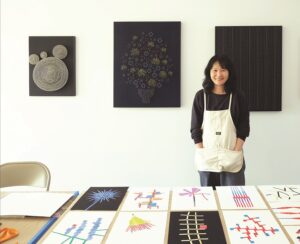
“Seeing all the gardens and blossoms was wild,” she says. “I had not experienced that in New York. I had never seen so many variations of flowers.” They soon found their way into her artwork — rendered not with paint or pencils but with pins.
The current three-person exhibition at Land’s End Gallery and Books includes artwork influenced by her time in Provincetown. The show, titled “Zone 7a,” refers to Provincetown’s plant hardiness, alluding to the nourishment and inspiration that Sohn and the others in the show — Cole Barash and Mischa Richter — have found in the Outer Cape landscape and environment. “My New York work is all black and white,” says Sohn. “Here it’s all color. This is probably the most decorative I’ve gotten. It makes me uncomfortable, but I’m letting it live.”
She describes her work as colorful, yet it’s relatively subtle. Her palette is limited by the standard colors of the rounded plastic tops of the straight pins with which she creates her images. Placed one at a time in a cork board, the pins delicately conjure images that range from flowers to biomorphic abstractions.
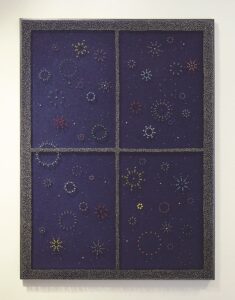
Sohn, who has an M.F.A. in sculpture, is a master manipulator. The pins, functioning as both a drawing tool and sculptural material, transcend their typical purpose or appearance. In one piece, the pins create the rigid architectural form of a window. Used to a much different effect, they describe airy, orb-like forms beyond the window, which expand outward like concentric ripples on water. In other pieces, she adjusts the density between colorless pins to create different values or inserts the pins to different depths to create movement on the surface of the image. The sensitivity in her work is well matched with Barash’s pale landscape photographs printed on rice paper and polyester camping equipment. Both artists create quiet work and obliquely approach sculpture with two-dimensional imagery.
Sohn started working with pins to create art when she was a fellow at FAWC. “I was looking at what’s immediately available,” she says. At the time she could easily source pushpins from Staples online, and she started using them to create singular images of things like zebras and butterflies. Their pixelated appearance echoes the early days of the digital age. “As an artist, I should be able to make work in any circumstance,” says Sohn. “My materials are affordable. They’re not high tech. I don’t need a foundry. There’s a lot of labor and repetitive processes,” she adds.
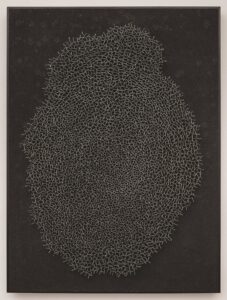
During the pandemic she had to leave her studio and began working in her Queens apartment. In her studio, she had been working on a sort of self-portrait — an egg-shaped form constructed solely from aluminum foil that was the same weight as herself. It required a lot of pounding — a process she couldn’t continue in an apartment with neighbors. “I had to figure out different ways of trying to use the same material,” says Sohn. Her solution was to create a smaller-scale string ball with cut strips of foil. The result is on view in her current show.
“I had to figure out a different way to use the same material,” says Sohn. “Making the ball kept me sane for six months.”
Sohn’s repurposing of common materials is an act of both translation and adaptability with parallels to her immigrant experience. At nine she left South Korea, where her grandmother had raised her, to live with relatives in a small Virginia town.
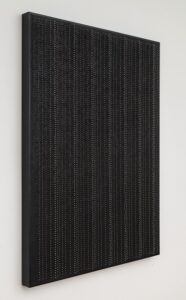
“I was sent on a plane and arrived and had to figure out how to communicate with everyone,” says Sohn. She spoke no English and was the only foreign student in her school. “They didn’t know what to do with me,” she says. “I made doodles and drawings and that’s how I would communicate with the kids.”
Some things were lost in translation. She recalls a Christmas gift exchange where students had to bring in a wrapped present. Having never celebrated Christmas, she thought wrapped presents were merely decorations, so she brought a beautifully wrapped but empty box.
“Miscommunication became interesting,” says Sohn. She names humor and “seeing things in a way not generally seen” as elements of her immigrant experience that have influenced her art.
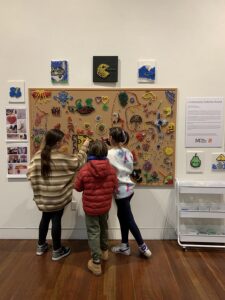
As Sohn adapted to life in America, art became a refuge and source of identity in the face of instability in her living situation. “I moved a lot,” says Sohn. Living with her relatives, who ran a convenience store, didn’t work out. “The first day I arrived, I was stocking sodas,” says Sohn. “I loved school because I could get away from there.” Eventually, she entered the foster-care system and then lived at a children’s home run by the Church of Christ before finding a family to live with during her last year of high school. “Art kept me focused,” says Sohn. “It was an area where everyone supported me.”
In high school she developed her interest in art and fashion, but the art program lacked rigor. “One art teacher was half blind and the other was carving ducks for his kid’s doll house,” says Sohn. Luckily, a new, more ambitious art teacher arrived and helped her prepare a portfolio for art school. She ended up at Parsons in New York and then Yale for graduate school before arriving in Provincetown in 2001.
Sohn’s return to Provincetown after living and working in New York for nearly two decades came at the right time. “I was dying to get out of New York,” says Sohn. “I needed a change.” She’s still finding her way here, including finding stable housing, but in the meantime she has been connecting to the local community. She showed her artwork at the Mary Heaton Vorse house last year, will be working at Land’s End Gallery this summer, and recently initiated an installation of pin-based artwork with students at PAAM. “I’m slowly getting more involved,” says Sohn. “I feel there’s still more time for me here.”
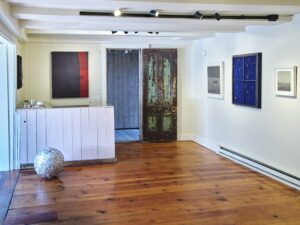
In her Provincetown studio, which she landed through her FAWC connection, Sohn is currently working on a series of collages that she will show at Schoolhouse Gallery in September. They are nimble, colorful abstractions created from painted paper. She works on them daily, approaching them intuitively without much intention. Like her other art, this work comes out of an engagement with whatever is at hand.
“I was getting frustrated with finding someone to build my panels and not having a car,” says Sohn. “ ‘Let’s go back to the basics,’ I thought.” With some paper, simple paints, scissors, and glue, she got to work. “Make things in whatever circumstance,” she says — a motto that has long guided her practice.
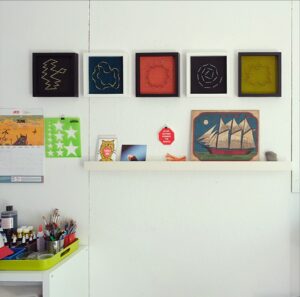
From Zone 7a
The event: Works by MiYoung Sohn, Cole Barash, and Mischa Richter
The time: Through July 6
The place: Land’s End Gallery and Books, 437 Commercial St., Provincetown
The cost: Free



